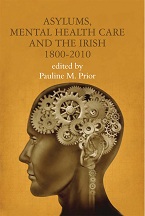On Thursday, October 5th, the school will mark the beginning of a new academic year with a special event marking the production of ten new books within the school in 2012. The titles span a vast array of topics including social deprivation, welfare, motherhood, rural life and the social significance of the Olympic Games. Each book will be introduced in brief by the author or editor, all of whom will be available for comment and discussion afterwards.
The launch was initiated by the Identities, Lifestyle and Culture research cluster. Cluster director Robert Miller said that the list of titles underlined the diverse strands of research being pursued to a high standard across the school. He added, “The event itself is a great opportunity to acknowledge the work and dedication of these authors and editors, as well as for others to hear what goes into getting books like these completed and out into the world.”
“The Evolution of European Identities: Biographical approaches” (Palgrave) is edited by Miller and explores the lack of identification by ordinary citizens with Europe and European institutions. Using state of the art analysis of in-depth interviews by renowned practitioners, the book provides a unique “bottoms up” perspective on the development (or its lack) of a sense of “European mental space”. Linking conceptual findings with case studies, the book provides unique insights into groups that have been especially sensitized by their life experiences to question what it means to be European in the twenty-first century. In this book, the editor brings together explorations of diverse groups, including adults who experienced European education exchanges when young; transnational workers; civil society organization activists; persons involved in cross-border intimate relationships; farmers who are subject to European markets, regulations and subsidies; and migrants into “fortress Europe”.
In “Poverty and Deprivation in Europe” (Oxford University Press), Brian Nolan and Chris Whelan attempt to redress the reliance on primary household income measures to capture poverty in rich countries. Awareness of the limitations of income has heightened interest in the role of non-monetary indicators. This book takes as its starting point that research on poverty and social exclusion has been undergoing a fundamental shift towards a multidimensional approach.
The difficulties encountered in applying a multidimensional approach reflect limitations in the information available but also in the conceptual and empirical underpinnings provided by existing research. This is salient not only for individual countries but also for the European Union post-enlargement. The central aim of this book is to contribute to development of those underpinnings and to provide ways of employing non-monetary indicators. The book maps out the current landscape and the best way forward, concluding by offering a critical evaluation of the EU’s 2020 poverty reduction target.
“The Olympic Games, Mega-Events and Civil Societies. Globalization, Environment, Resistance” by John Karamichas and Graeme Hayes (Palgrave) explores sports mega-events; their social, political and cultural characters; the value systems that they inscribe and draw on; the claims they make on us and the claims the organizers make for them; the spatial and ethical relationships they create; and the responses of civil societies to them. Sports mega-events are not simply sporting or cultural phenomena. They are also political and economic events, characterized by the generation and projection of symbolic meanings and by social conflict. Because of their peculiar spatial and temporal organization, they raise questions about the relationships between global cultural and economic flows and particular local and national spaces. Because of their evolutionary characteristics, they ask us to consider not simply the time of the event but also the effects of the event on the long-term direction, implementation and consequences of public policy.
In “Demands of Motherhood: Agents, Roles and Recognition” (Palgrave),Lisa Smyth returns to the deeply contested and emotionally fraught role of motherhood. Motherhood is the focus of much public scrutiny, situated as it seems to be at the frontier of processes of social order and change. Much has been written about the difficulties of mothering in a context of ever-expanding expert advice, as well as apparently increasing expectations that the mother-child bond be cultivated through intensive care-giving.
In this study, Smyth returns to neglected sociological questions concerning the connections between agency and normative complexity, through the pragmatist interpretation it offers of the recognition dynamics shaping motherhood. Drawing on qualitative interviews with forty mostly middle-class mothers across two research sites, Northern Ireland and the US, this book offers a three-party typology of the coping strategies women adopt. The various combinations of expressivism, instrumentalism and pragmatism taken up by respondents as they go about asserting normative authority and seeking esteem for the competence and quality of their mothering, provides the focus of attention.
“Post-Qualifying Mental Health Social Work Practice” (Sage) is an extensive treatment by Jim Campbell and Gavin Davidson of the complex and difficult practice dilemmas faced by social workers working in the area of mental health, and the demanding policy and legal landscape surrounding practice in the area. The authors draw on theoretical and research perspectives on the subject, before outlining how professionals can achieve best practice. Topics covered include: models of mental health and illness; discrimination and social exclusion; addressing service users’ needs; carers’ perspectives; and working with individuals, families and communities. The chapters are accompanied by exercises, which encourage readers to critically reflect on their own professional and personal experiences. The book will be particularly useful for social work practitioners taking postgraduate courses in mental health and for those training to become Approved Mental Health Professionals.
Mary Daly’s “Welfare” (Polity Press) examines how welfare is understood across a range of disciplines and considers the relevance of the concept in the light of recent debates and scholarly developments. Not alone is welfare challenged by new concepts but it is also challenged as a political goal. Hence, the discussion of welfare raises large issues about policy. The book is especially concerned with three aspects of welfare – as a focus of academic thinking and research; as it has informed and been taken up by public policy (in the context of the welfare state especially); and as a way of understanding people’s decisions and actions in their everyday lives. The book takes a fresh look at the case for the continuing relevance of welfare and in so doing offers a novel approach, drawing especially on a multi-disciplinary approach.
In “Blades, Blood and Bandages” (Palgrave), the taboo phenomenon of self-injury is examined. Author Theresa McShane draws on the experiences of 25 people who cut, burn or otherwise injure themselves who present their perspectives through interviews, diaries and poetry. The book explores issues of causation and suffering, stigma and ritual, and presents a helpful alternative to medical classifications of self-injury.
The book uses an original theoretical concept – the trajectory of suffering – to explain patterns of self-injury, from “causation”, through “ongoing injury” to “post injury”. It finishes with an explanation of the social face of self-injury and the structural influences on self-injury of both popular culture and the internet.
Asylums, Mental Health Care and the Irish 1800-2010 (Irish Academic Press) is edited by Pauline Prior, and comprises fascinating historical essays from well known scholars on a wide variety of topics in relation to mental health services in Ireland during the past two centuries. Topics covered include a major strike in 1919, when nurses flew a red Soviet flag over the building and rallied leaders of the trade union movement to their cause; poetry and prose from patients at Holywell Hospital in the 1960s; stories of Irish emigrants who went to Australia and New Zealand in the 1800s to find gold, but who ended up in asylums; changes in law and approaches to mental health care in Ireland in the twentieth century; and detailed studies into approaches to care and treatment at Ballinasloe, Belfast, Dundrum and the Richmond.
“Irish Social Work and Social Care Law” (Gill & MacMillan) is a new textbook by Claire Hamilton introducing students to the law governing the practice of social work and social care in Ireland. The book provides a clear and concise guide to both the legal framework and the substantive law relating to social care and social work. It presents social care and social work law in an accessible manner, focussing on the specialist functions performed by social care professionals such as child protection, adopting and fostering, disability and mental health. It also considers the broader issues that affect service users in a social care context such as domestic violence, youth justice and the asylum system. The impetus for the book was the absence of a legal text dealing with social work and social care law in the Republic of Ireland equivalent to Ciaran White’s text in the North.
In Rural Transformations and Rural Policies in the US and UK (Routledge), editors Mark Shurcksmith, David Brown, Sally Shortall, Jo Vergunst and Mildred Warner set about illustrating the transformations that have occurred in rural areas and related policies. The political, social, economic, cultural and environmental landscapes of rural areas have changed utterly. Processes of globalisation and related decentralisation, population shifts, technological and industrial changes have resulted in the transformation from one rural societal form to another. This transformation does not only consist of the visible or tangible changes in rural areas, but it also includes the narratives and social construction of rural areas. In this comparison of the US and the UK, we examine four key components of rural transformation; rural policies and governance, economic transformations, social and demographic transformations, and rural environments. In each case we examine the evidential and philosophical nature of these transformations.


